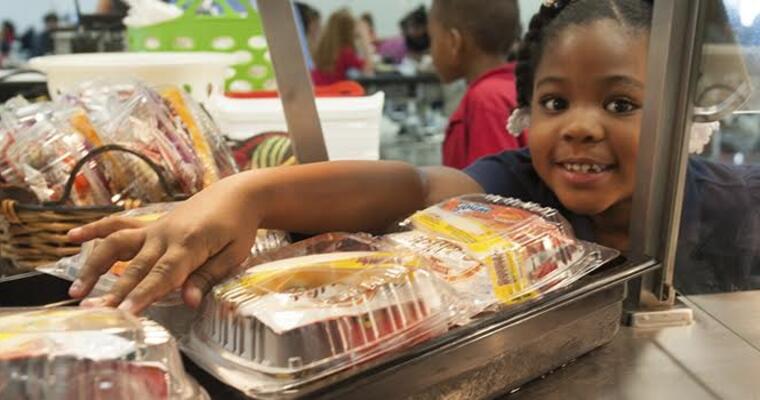When it comes to studying school food and nutrition programs, many districts could learn a lesson from the programs at Hillsborough County Public Schools in Tampa, Florida.
Mary Kate Harrison, Ph.D., the General Manager of Student Nutrition Services at the 200,000-student district, oversees a team dedicated to feeding young people all year long—during the school year and through an elaborate summer feeding program. While the focus of healthy eating is aimed at building stronger bodies and minds, Harrison’s foodservice team doesn’t overlook the enjoyment and social goodwill behind every meal.
Summer Food Program
As summer vacation approaches, food programs go dormant at many schools, but not Hillsborough’s. Starting immediately after classes end, Harrison’s team launches into a summer food program that provides more than 15,000 lunches and breakfasts daily. Of the district’s 270-plus schools, about 100 are open for meals. Meanwhile, the district’s production center loads a dozen trucks with breakfasts and lunches that are served Monday through Friday at about 150 parks, camps, and recreation centers where eligible children gather.
Program Aims to Reach More Students
To make the program more accessible for students without transportation, Hillsborough introduced Movin’ Meals in 2012, turning three school buses into mobile food-truck cafeterias, complete with booths to make the meals more personal. The buses travel to various meal locations and provide an airconditioned spot for students to sit and eat. For those who prefer the fresh air, a tent outside each bus provides a shady spot for picnic-style dining
“Each bus makes four stops, and they feed 300 children per day,” Harrison says. “We treat each bus like a restaurant on wheels.”
Hillsborough was the first in Florida to start a summer food program in 1991, and there were many matters to consider. Meals served away from school sites start at a production facility, where the thousands of breakfasts and lunches are prepared a day in advance and loaded into a dozen full-size, refrigerated semitrailers for delivery to 150 locations.
Each site then receives that day’s lunch and breakfast for the next morning. This presents a couple of challenges. First, each site must own, rent, or lease enough cooler space to store meals. Second, the foodservice team needs to assemble meals that store well in tight spaces. And that’s bad news for bananas.
“Fresh fruits can be a problem,” Harrison says. “When you put a banana in a box and that box gets tightly packed in a cooler, smashed bananas are the result.”
When it comes to summer eating, students are treated to cold meals. For breakfast, it’s muffins, protein bars, peanut butter and jelly bars, and milk or juice. For lunch, it’s a sandwich, wrap, or hoagie with ham and cheese or roast beef, carrots or broccoli and dip, Sun Chips, and milk or juice. The solution to the unintended banana-pudding problem: sealed fruit cups are packed frozen, and as they thaw a bit during the delivery and cooler storage, they become slushy fruit snacks that are a big hit with youngsters.
Summer meals are something families and hungry students depend on, so Harrison says dedication and attention to detail are essential.
“It’s an all-summer commitment for our staff. We must have a vision for the mission,” she says. “If you’re planning a summer cruise or a long family vacation, it’s just not going to work out.”
Thinking Outside the Box
Hillsborough is trying new ways—and fun methods—to fill students’ stomachs. From a student dinner program to culinary showdowns, innovation goes far beyond their summer feeding program.
The district has an after-school dinner program in place at 14 schools. Hot meals—spaghetti and meatballs, baked ziti, fruits and vegetables, and milk—are served until 5 p.m.
“We had to get community buy-in for the dinner program,” Harrison says. “It’s not a substitute for sitting down with the family at night. We’re not competing with family time, just providing nutrition to students who otherwise might go without.”
Hillsborough also runs a “Fresh Fruit & Vegetable Program” at 50 schools. It is run like a grant, with money allotted for each qualifying child to make sure a fresh fruit or vegetable snack is given daily. The snack comes to the classroom with fact sheets about the food, such as where it’s grown and how it’s harvested. Some teachers use it as an education tool.
To introduce new foods, Hillsborough started “Try It Tuesday,” at all 235 schools with dining preparation areas. The district’s executive chef creates recipes, such as butternut squash bisque, broccoli and rice casserole, or pineapple jalapeño relish, which is sampled at schools.
“Each student who tries the food gets a ‘Super Food Taster’ sticker,” Harrison says. “And at least two items—roasted cauliflower and black bean quinoa salsa—have been added to the menu by popular demand.”
That’s just the start of the fun. For the past three years, students have been able to be the chef with the “Cook It Up” competition. Each participant comes up with a recipe, gives it a name, writes something about it, and hopes to become one of the finalists at a cook-off competition.
“I think we have a bunch of future Food Network stars on our hands,” Harrison says. “Local food bloggers, cooks, and chefs judge the creations, and the winner’s dish is served on the districtwide menu later in the year”




























